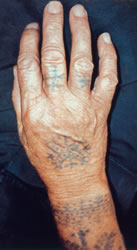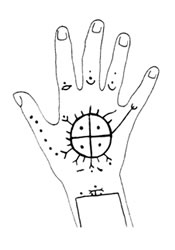Tattooing in North Africa, The Middle East and Balkans
Article © 2010 Lars Krutak
BALKAN TATTOOING
The Romans, who exacted their rule over the Balkans for centuries, brought a variety of cults to the area, especially that of Mithras. A capital doctrine of Mithraism was fatalism, where the destinies of humankind were bound to the planets. The sun, the greatest of them, influenced kings and emperors. Each day of the week was sacred to a planet and December 25, the birthday of Sol Invictus (“Invincible Sun”), was especially holy and is now fêted as Christmas. An immense mountain towered above the sun, moon, and stars and was the home to the immortals. After death, the spirits of light and darkness struggled for the soul, which, if it escaped darkness, rose first to the moon and then passed to the six other planets to be cleansed before reaching eternal bliss.

|
 |
(Far left) Bosnian woman’s hand tattoos, 2000. Photograph © Michael Laukien.
(Left) Arab woman's hand tattoo from Iraq, ca. 1930.
|
After Constantine the Great (ca. 280-337 A.D.) moved the seat of the Roman Empire to Byzantium (Istanbul) and adopted Christianity as the religion of the state, Mithraism nearly fell out of favor. However, Constantine, before taking this step, was a follower of Mithras, which accounts for the fact that his standard, the Labarum, bears a striking resemblance to the sun-wheel: it was even marked on Byzantine coins until the 7th and 8th centuries. In these coins, the cross, which began as a sun-wheel, is the most prominent, and a small sun appears at the end of each – or a crescent-like object, which may represent the moon or be a broken sun-wheel. It is these combinations of moon, sun and cross that the Arab, Albanian, Bosnian, and Kurdish tribeswomen tattooed on their arms and bodies. |
|
Although Mithraism eventually died out, it is obvious that specific symbols associated with that religion did not. In the 9th century, Manichaeism, a strange compound of sun worship, Zoroastrian Dualism, Babylonian folklore, Buddhist ethics and Christianity, entered the Balkans and spread rapidly throughout districts where Mithraism had once flourished. This new religion purported to be the true synthesis of all the religious systems then known, and the essential part of this faith was a belief in two antagonistic powers of Light and Darkness, spirit and matter. Durham stated:
Man was created by the powers of Darkness, but contains some stolen particles of Light. Woman contains no particles of Light and is, therefore, an instrument of destruction. Christ was the efflux of the Power of Light and had His dwelling place in the sun. To the sun where drawn those souls in whom the principle of Light prevailed, and they passed onward for ablution in the pure water that formed the moon. When the moon was full of souls, they passed from it, thus accounting for the waxing and waning of the moon. Finally, the souls dwell in a column of light, because it is filled with perfect souls. The celestial bodies were witnesses of the great strife and took part in it. The spirits of evil were caught and bound to the stars. Hence the maligning influence of the constellations and the destructive force of the elements.
Next Page | 1
|
2 |
3 |
4 |
5 |
6 |
7 |
8 |
Museum photo gallery of the images
on this page may be seen here.
|


